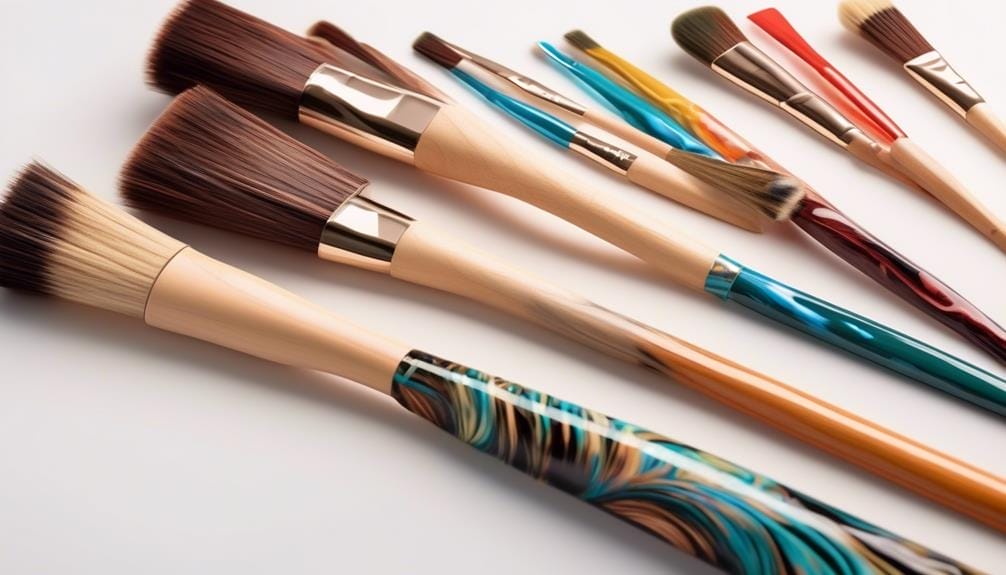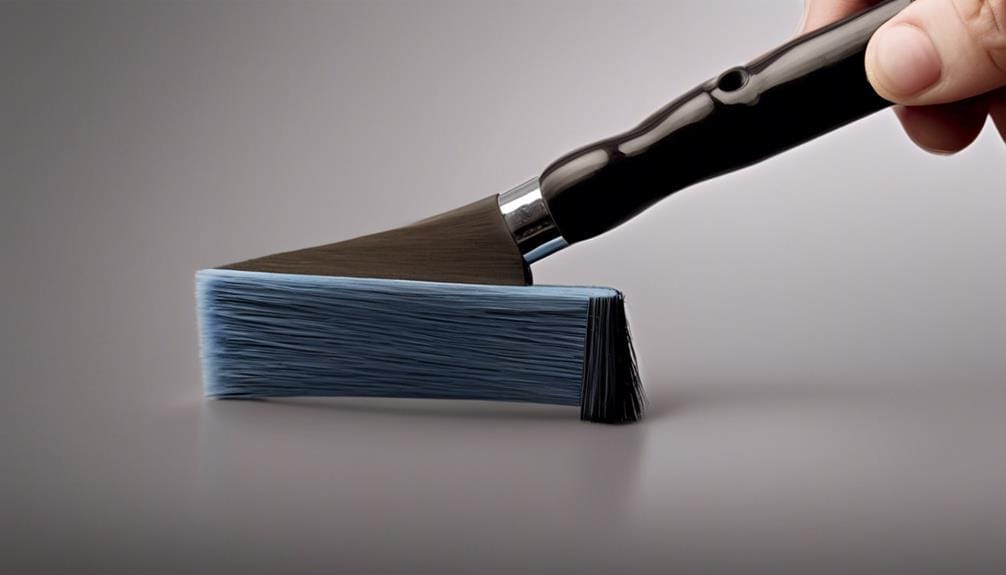Imagine you're a painter, standing before a blank canvas, ready to bring your vision to life. But before you can start, you need the right tools.
Epoxy Tools and Accessories are like the brushes and paints in an artist's studio—they are the essential elements that allow you to create something beautiful and enduring. From safety gear to surface preparation tools, these accessories are designed to help you achieve professional results in your epoxy projects.
But there's more to discover, so let's dive in and explore the world of epoxy tools and accessories together.
Key Takeaways
- Safety gear is essential when working with epoxy to reduce the risk of accidents and harmful effects.
- Choosing the appropriate mixing tools, such as roller covers and chip brushes, is crucial for thorough mixing of epoxy components.
- Selecting the right application brushes for precise and efficient epoxy application is important for achieving a smooth and professional finish.
- Proper brush care, including cleaning and storage, ensures the longevity and performance of brushes.
Safety Gear
When working with epoxy products, it's crucial to prioritize safety by utilizing the appropriate protective gear.
Safety gear, such as rubber gloves and spike shoes, is available to protect you from potential hazards. To ensure a comfortable and secure fit, various sizes and types of gloves, along with spike shoes, are offered. These safety gear options are made of durable materials that can withstand the demands of working with epoxy and related products.
When choosing the right safety gear, it's essential to refer to the fitting guide provided by the manufacturer. This guide will help you select the appropriate size and style that accommodates your specific needs and preferences.
Rubber gloves and spike shoes are recommended for their ability to shield you from potential injuries and ensure a safe working environment. By wearing the recommended safety gear, you can reduce the risk of accidents and protect yourself from any harmful effects associated with epoxy products.
Remember to always prioritize your safety and use the appropriate protective gear when working with epoxy.
Mixing Tools
To ensure the proper mixing of epoxy products, a variety of mixing tools are available, including roller covers, multi-mix containers, chip brushes, and paint tray liners. These tools are designed to make the mixing process efficient and effective, allowing you to achieve the desired consistency for your epoxy applications.
Here are some key points to consider when using mixing tools:
- Mixing techniques: When using roller covers or chip brushes, it's important to use a stirring motion to combine the epoxy components thoroughly. This ensures that all the ingredients are properly mixed and there are no streaks or clumps in the mixture.
- Choosing the right container: Multi-mix containers are specifically designed for mixing epoxy products. They've graduated measurements on the side, allowing you to accurately measure and mix the epoxy components in the correct proportions. It's important to choose a container that's large enough to accommodate the volume of epoxy you're working with, while also providing enough space for thorough mixing.
- Roller covers and chip brushes: Roller covers and chip brushes are commonly used for mixing epoxy on larger surfaces. The bristles or nap of these tools help to distribute the epoxy evenly, ensuring a consistent mixture.
- Paint tray liners: Paint tray liners are disposable inserts that fit into paint trays. They're useful for mixing small batches of epoxy and provide an easy cleanup option. Simply remove the liner after mixing and dispose of it, leaving your paint tray clean and ready for future use.
Application Brushes

When it comes to application brushes for epoxy coatings, there are a few key points to consider.
Firstly, brush types and sizes vary to accommodate different application needs, so it's important to choose the right brush for the job.
Secondly, proper brush care is essential for maintaining their performance and extending their lifespan.
Lastly, using the best brush application techniques will ensure a smooth and professional finish.
Brush Types and Sizes
Different brush types and sizes are essential for achieving precise and efficient epoxy application. When it comes to brush types, chip brushes and application brushes are commonly used. Application brushes are available in various sizes, including 1 inch, 2 inches, and 3 inches, allowing you to choose the right size for your project needs.
Here are some key points to consider when selecting brush types and sizes for epoxy application:
- Coverage: Larger brushes are suitable for covering larger surface areas, making them ideal for big projects or when you need to apply epoxy quickly.
- Detail work: Smaller brushes are perfect for detailed work and reaching tight spaces, ensuring that you can achieve precision and accuracy.
- Efficiency: Choosing the appropriate brush type and size ensures efficient epoxy application, saving you time and effort.
- Professional finish: Using the right brush types and sizes leads to a professional finish, enhancing the overall appearance of your epoxy project.
Remember to store your brushes properly and perform regular maintenance to prolong their lifespan and ensure optimal performance.
Proper Brush Care
Proper care of application brushes is crucial for maintaining their performance and longevity. To ensure your brushes stay in optimal condition, it is essential to follow proper brush care practices. After each use, thoroughly clean the brushes to prevent hardened epoxy from ruining them. Use appropriate solvents, such as acetone or denatured alcohol, to effectively remove epoxy residue. Additionally, store your brushes in a way that prevents deformation and maintains their shape. Consider hanging them or laying them flat to prevent bristle damage. For long-term maintenance, use a brush comb to remove debris and maintain the brush's bristles. Regularly inspect brushes for wear and tear, and replace them when necessary to ensure optimal application results.
| Brush Storage Tips | Brush Maintenance Tips |
|---|---|
| Hang brushes or lay them flat to maintain their shape | Thoroughly clean brushes after each use to prevent hardened epoxy |
| Avoid storing brushes in a way that can cause deformation | Use appropriate solvents, such as acetone or denatured alcohol, for effective cleaning |
| Store brushes in a clean and dry area to prevent contamination | Regularly inspect brushes for wear and tear, and replace them when necessary |
| Consider using a brush comb for long-term maintenance |
Best Brush Application Techniques
To achieve a smooth and even application of epoxy, it's crucial to employ the best brush application techniques with high-quality brushes and proper loading techniques. Here are some tips to help you achieve the best results:
- Use a high-quality brush with soft, synthetic bristles. This will ensure a smooth application and minimize brush marks.
- Load the brush with an appropriate amount of epoxy. Avoid overloading the brush to prevent drips and runs.
- Apply epoxy in thin, even coats. This will provide better coverage and minimize the visibility of brush marks.
- Start painting from the edges and work towards the center. This will help you control the application and avoid excess buildup.
Remember to clean the brush immediately after use using the recommended solvent. Proper brush maintenance will ensure its quality for future applications. If you encounter any issues during the application process, refer to troubleshooting tips for guidance.
Surface Preparation Tools

To properly prepare the surface for epoxy application, you need to focus on two key points: cleaning and sanding, and priming and degreasing.
Cleaning and sanding the surface ensures the removal of any dirt, debris, or imperfections that could affect the adhesion of the epoxy.
Priming and degreasing help create a clean and smooth surface, allowing the epoxy to bond effectively and create a durable finish.
Cleaning and Sanding
For precise and detailed cleaning and sanding on epoxy surfaces, a 2in. Chip Brush is an excellent tool to consider. The bristles of the chip brush are designed to effectively remove debris and dirt from the surface, ensuring a clean and smooth finish.
When sanding epoxy surfaces, it's important to use proper techniques to achieve the desired results. Here are some sanding techniques to keep in mind:
- Start with a coarser grit sandpaper and gradually move to a finer grit for a smoother finish.
- Use long, even strokes to prevent uneven sanding marks.
- Always sand in the direction of the grain for a more uniform appearance.
- Regularly clean the sandpaper to prevent clogging and maintain its effectiveness.
To enhance the cleaning and sanding process, using appropriate cleaning solutions is essential. These solutions can help remove stubborn stains and ensure a clean surface for further treatment.
Priming and Degreasing
When preparing epoxy surfaces, priming and degreasing are essential steps that ensure better adhesion and eliminate any contaminants that could affect the epoxy bond. Proper priming is crucial for achieving optimal epoxy adhesion. It creates a bonding surface that allows the epoxy to adhere securely, resulting in a strong and durable finish.
Degreasing the surface is equally important as it removes any oils, grease, or contaminants that could interfere with the epoxy bond. Surface cleaning tools such as brushes, rollers, containers, and protective gloves are commonly used for priming and degreasing. These tools help in achieving a clean and well-prepared surface, ensuring successful epoxy application.
Measuring and Dispensing Tools
Measuring and dispensing tools play a crucial role in achieving accurate and professional epoxy mixing and application. To ensure precise measurement and dispensing of epoxy components, there are several tools available in the market. Here are four essential tools that can assist you in achieving high-quality epoxy finishes:
- Epoxy Syringe: An epoxy syringe allows for controlled and accurate dispensing of small amounts of epoxy. This is particularly useful when working on intricate projects or when filling small gaps and cracks.
- Digital Scale: A digital scale is an indispensable tool for measuring epoxy components by weight. This ensures accurate ratios and consistent results, especially when working with epoxy systems that require precise mixing ratios.
- Multi-Mix Containers: These containers are designed with graduated markings, making it easy to measure and mix epoxy components accurately. They come in various sizes, allowing you to choose the right container depending on the volume of epoxy you need.
- Paint Tray Liners: These disposable liners fit into standard paint trays and are perfect for mixing epoxy. They make clean-up a breeze and prevent cross-contamination when working with different epoxy colors or materials.
Using these measuring and dispensing tools, such as the epoxy syringe, digital scale, multi-mix containers, and paint tray liners, will help you achieve professional and flawless epoxy finishes.
Finishing Accessories

Finishing accessories, such as roller covers, paint trays, chip brushes, and multi-mix containers, are essential tools for achieving professional and flawless epoxy finishes. Epoxy Systems International offers a wide range of these accessories, catering to different project needs. The prices of these accessories vary from $1.20 to $130.0, ensuring that there are options available for every budget. To make it easier for customers to find the accessories they need, sorting options are provided, including title A-Z, title Z-A, date old to new, date new to old, price low to high, price high to low, and discount high to low. Additionally, some of the accessories are currently on sale, providing cost-effective options for epoxy finishing needs.
In addition to the basic finishing accessories, Epoxy Systems International also offers other products that can enhance the epoxy application process. Mini rollers, duct tape, rubber gloves, paint mixers, and spike shoes are among the additional products available. These accessories can help achieve decorative options and specialty finishes, allowing for more creative and unique epoxy projects.
Whether you're looking to create a smooth and glossy finish or add texture and patterns, these finishing accessories can assist in achieving the desired result.
Frequently Asked Questions
What Is 20 Times Stronger Than Epoxy?
Looking for stronger materials than epoxy? Look no further than 20 Times Stronger Than Epoxy. This revolutionary adhesive offers exceptional strength and durability, making it the perfect alternative to standard epoxy.
What Is the Best Applicator for Epoxy Paint?
The best applicator for epoxy paint is the Pro Roller 18in. X 3/8in. Roller Cover. It provides a smooth and even application, making it the ideal choice for achieving a flawless epoxy finish.
What Epoxy Do Professionals Use?
Professionals use epoxy for various applications like flooring, countertops, and industrial coatings. Factors to consider when choosing the right epoxy include durability, chemical resistance, and curing time. It is crucial to select a product that meets the specific project requirements.
What Works Better Than Epoxy?
There are several alternative options that work better than epoxy for specific applications. Polyester resin is more flexible and water-resistant, polyurethane adhesives are preferred for bonding materials with different coefficients of thermal expansion, and cyanoacrylate is effective for wood repairs.
Conclusion
In conclusion, the collection of Epoxy Tools and Accessories from Epoxy Systems International offers a wide range of products to assist with epoxy application.
From safety gear to finishing accessories, these tools provide the necessary support for a successful epoxy project.
One interesting statistic is that the collection includes 59 different products, catering to various needs and preferences, ensuring that there's a suitable tool for every epoxy application.





